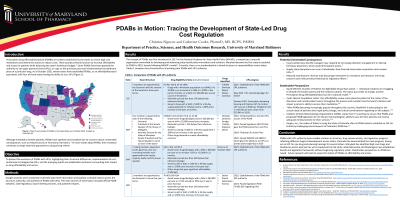Drug pricing, payment, and reimbursement
E-Poster Available
(127) PDABs in Motion: Tracing the Development of State-Led Drug Cost Regulation
Wednesday, October 29, 2025

Christina Nguyen
University of Maryland School of Pharmacy
GERMANTOWN, Maryland, United StatesChristina Nguyen
University of Maryland School of Pharmacy
GERMANTOWN, Maryland, United States
Presenter(s)
Primary Author(s)
Background: : Prescription Drug Affordability Boards (PDABs) are relatively new state-established oversight bodies designed to protect patients from the high costs of prescription medications. While their core mission is consistent—to ensure drug affordability—each PDAB operates under unique legislative frameworks and implementation criteria. These boards conduct affordability reviews to evaluate the financial impact of medications and develop strategies to control spending. Although intended to benefit patients, these efforts have sparked some backlash due to concerns such as reduced access or formulary restrictions.
Objective: : To describe the current status of PDABs by comparing their structure and implementation of cost-containment strategies, such as Upper Payment Limits (UPLs).
Methods: : A Google search was conducted to identify state-level information and publicly accessible data to assess the structure, authority, and activities of PDABs with UPLs. The main sources of information included official PDAB websites, state legislation, board meeting minutes, and published reports. Additional internet searching was performed within news outlets, policy analyses, and stakeholder commentaries.
Results: : The search identified four states with PDABs with UPLs: Colorado, Maryland, Minnesota, and Washington. There is variability in structure, drug review activity, and regulatory progress. Colorado’s PDAB demonstrates the most regulatory progress, initiating UPL rulemaking for one selected drug and planning multiple hearings for the remaining four selected drugs. Maryland has selected six high-cost drugs and finalized a UPL Action Plan, though no UPLs have been formally set. Minnesota has completed board appointments and possesses UPL authority, but has not yet identified drugs or initiated regulatory processes. Washington’s PDAB has made partial board appointments, but no drugs have been selected or affordability actions initiated. Drug selection strategies have been defined in Maryland and Colorado with both states targeting high-cost treatments for chronic conditions, while Washington and Minnesota are still defining their focus.
Conclusions: : PDABs with UPLs reveal significant variation in structure, drug review activity, and regulatory progress. PDABs are in different stages of development, with some being newly developed and others with established action plans. Collectively, these findings illustrate a landscape of uneven yet evolving state-led drug cost regulation, with each PDAB charting its path toward affordability interventions.
Sponsorship:: None
